
Amid the escalating demand for energy-efficient solutions, commercial tinting stands out as an innovative approach to augment building efficiency. Commercial tinting, a process of applying a thin laminate film to the interior or exterior of glass surfaces in commercial buildings, offers a plethora of benefits including reduced energy costs, improved aesthetics, and enhanced privacy. However, the potential of this technology extends beyond these immediate benefits. Recent advancements in commercial tinting solutions, such as the incorporation of solar control and thermal insulation properties, present significant opportunities for enhancing the energy efficiency of commercial buildings. As we explore this topic further, we will unravel how these innovative tinting solutions could redefine the future landscape of building efficiency.
Understanding Commercial Tinting Solutions
To fully grasp the concept of commercial tinting solutions, it is essential to delve into its fundamental characteristics, applications, and benefits in various commercial settings. Commercial tinting solutions primarily involve the application of a thin laminate film to the interior or exterior of windows in commercial buildings. This innovative solution is designed to improve energy efficiency, enhance privacy, and reduce glare. Tinting not only minimizes heat gain in the summer but also retains heat in the winter, thereby reducing energy costs. Besides, it plays a crucial role in enhancing the aesthetic appeal of commercial buildings. Therefore, understanding commercial tinting solutions is vital for business owners, property managers, and architects seeking to create efficient, comfortable, and visually appealing commercial spaces.
The Impact on Building Efficiency
Building efficiency is significantly influenced by the implementation of commercial tinting solutions, a fact that underscores its importance in sustainable architectural design and energy management. By reducing the amount of solar heat gain, these solutions contribute to a decline in the reliance on air conditioning, thus lowering energy consumption and associated costs. Likewise, during colder months, the insulating properties of commercial tinting can reduce heat loss, contributing to improved thermal comfort and efficiency. Furthermore, by mitigating the effects of harmful UV rays, they extend the lifespan of interior furnishings and fittings, leading to cost savings in maintenance and replacements. The integration of commercial tinting solutions, therefore, represents a significant stride towards achieving optimal building efficiency.
In light of the escalating urgency of sustainability, commercial tinting solutions stand at the forefront of building efficiency advancements. The potential energy savings, coupled with cost reductions and carbon footprint minimization, underscore the paradigm shift towards these innovative solutions. In the metaphorical race towards sustainable practices, commercial tinting solutions are rapidly emerging as a leading contender, paving the way for a more energy-efficient, environmentally-conscious future in commercial building design.